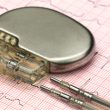Atrial fibrillation is the most common arrhythmia and its combination with a history of acute myocardial infarction or coronary angioplasty is quite frequent. According to this study (recently published in JACC), in a real-world population, the combination of direct anticoagulant agents and dual antiplatelet therapy reduces significantly the risk of bleeding and provides similar thromboembolic<a href="https://solaci.org/en/2018/11/20/safety-of-combining-new-anticoagulant-agents-and-dual-antiplatelet-therapy/" title="Read more" >...</a>
Surprises in the Physiopathology of Critical Ischemia
Luminal thrombotic occlusions associated with non-significant atherosclerosis are commonly observed in patients with critical lower limb ischemia, which suggests the possibility of thromboembolic disease as a great contributor to ischemia. This was particularly verifiable in infrapopliteal vessels, thus showing a possible mechanism of progression from peripheral vascular disease to critical ischemia, as well as a<a href="https://solaci.org/en/2018/11/13/surprises-in-the-physiopathology-of-critical-ischemia/" title="Read more" >...</a>
Myocardial Revascularization Surgery Hits a Plateau
Hopes were raised high by the ARTS study, when set to show the benefit of bilateral internal mammary arteries (BIMA) during coronary artery bypass graft surgery compared over the use of a single internal mammary artery (SIMA) at 10 year follow up, but only one sub-study was able to show an advantage over radial grafts.<a href="https://solaci.org/en/2018/11/07/myocardial-revascularization-surgery-hits-a-plateau/" title="Read more" >...</a>
Practical Management of Coronary Perforations
Coronary perforation has an incidence of 0.5% and it is associated with a 13-fold increase in in-hospital events and a 5-fold increase in 30-day mortality. This event is so catastrophic that its management has become indispensable knowledge to all interventional cardiologists. This accident is most frequently provoked by artery over-dilation caused by a balloon or<a href="https://solaci.org/en/2018/11/06/practical-management-of-coronary-perforations/" title="Read more" >...</a>
What Should We Use for the Functional Assessment of Coronary Lesions in Severe Aortic Stenosis?
This systematic analysis measured intracoronary pressure in different phases of the cardiac cycle and flow velocity in patients with severe aortic stenosis and coronary artery disease, who were scheduled for transcatheter aortic valve replacement (TAVR). The aim was to determine the impact of aortic stenosis on: 1) flow, at different phases; 2) hyperemic coronary flow;<a href="https://solaci.org/en/2018/10/30/what-should-we-use-for-the-functional-assessment-of-coronary-lesions-in-severe-aortic-stenosis/" title="Read more" >...</a>
Discharge During the Weekend After Cardiac Surgery Is Not Associated with Readmissions
According to this new work (soon to be published in Ann Thorac Surg), discharging a patient during the weekend or a holiday after cardiac surgery is not associated with higher rates of readmission compared with patients discharged during weekdays. A total of 4877 patients were discharged after cardiac surgery in high-volume sites in the United States. Among them,<a href="https://solaci.org/en/2018/10/29/discharge-during-the-weekend-after-cardiac-surgery-is-not-associated-with-readmissions/" title="Read more" >...</a>
Immediate Electrocardiography After TAVI, the Simplest Way to Predict Conduction Disorders
Taking into account a simple 12-lead electrocardiography performed immediately after transcatheter aortic valve implantation (TAVI), removing the temporary pacemaker immediately is safe in patients without right bundle branch block who are in sinus rhythm with PR interval <240 ms and QRS interval <150 ms. In cases of atrial fibrillation, a QRS interval <140 ms also reassures the decision<a href="https://solaci.org/en/2018/10/23/immediate-electrocardiography-after-tavi-the-simplest-way-to-predict-conduction-disorders/" title="Read more" >...</a>
Ambulatory Continuous Monitoring in Patients with Left Bundle Branch Block After TAVI
The incidence of arrhythmic events up to a year after implantation is high and involves almost half the patients with complete left bundle branch block following the procedure. Significant bradyarrhythmias occur in up to one-fifth of the patients, half of whom ultimately require a pacemaker. These data support the idea of a cardiac monitoring device<a href="https://solaci.org/en/2018/10/18/ambulatory-continuous-monitoring-in-patients-with-left-bundle-branch-block-after-tavi/" title="Read more" >...</a>
Predictors of Conduction Disturbances Requiring a Late Permanent Pacemaker
This analysis shows that baseline right bundle branch block and increased PR length after transcatheter aortic valve replacement (TAVR) are independent predictors of advanced conduction disturbances requiring late pacemaker implantation. A simple electrocardiography can detect these potentially fatal conduction disturbances that might happen more than 48 hours after TAVR. Data from consecutive TAVR patients from<a href="https://solaci.org/en/2018/10/18/predictors-of-conduction-disturbances-requiring-a-late-permanent-pacemaker/" title="Read more" >...</a>
2018 Peru Sessions | Nurses and Technicians Session
As a prologue to Peru 2018 Sessions, Nurses and Technicians Sessions will be held on October 24, 2018. The event will take place at the Main Arena of the National Cardiovascular Institute (INCOR), in Lima. These sessions will be about several topics, among others, radioprotection in the cath lab, valve disease procedures, TAVR, mitral valve,<a href="https://solaci.org/en/2018/10/11/2018-peru-sessions-nurses-and-technicians-session/" title="Read more" >...</a>









